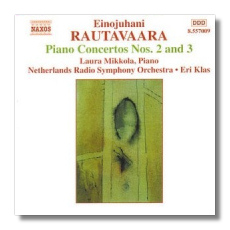
The Internet's Premier Classical Music Source
Related Links
- Rautavaara Reviews
- Latest Reviews
- More Reviews
-
By Composer
-
Collections
DVD & Blu-ray
Books
Concert Reviews
Articles/Interviews
Software
Audio
Search Amazon
Recommended Links
Site News
 CD Review
CD Review
Einojuhani Rautavaara

Piano Concertos
- Piano Concerto #2
- Piano Concerto #3 "Gift of Dreams"
- Isle of Bliss
Laura Mikkola, piano
Netherlands Radio Symphony Orchestra/Eri Klas
Naxos 8.557009 DDD 62:06
Einojuhani Rautavaara (b. 1928) studied with Merikanto, Persichetti, Copland and Sessions. But the music here betrays no influence one might readily associate with any of these figures. Instead, in the concertos there is a dreamy, rather unique character that often alternates with a dramatic, sometimes turbulent manner. Overall though, it is the dreamy, more subdued style that dominates.
The Third Concerto comes before the Second on the disc. Written for Vladimir Ashkenazy, who premièred it in 1999 with the Helsinki Philharmonic, it opens in the strings in the spirit of Bartók's Night Music, displaying the kind of eerie character heard in the middle movement of his Second Piano Concerto. Not that Rautavaara imitates Bartók here, but his music does share a spiritual kinship with aspects of that Hungarian master's style. Most of the Tranquillo first movement is tranquil indeed. The ensuing panel is a lovely Adagio assai, which at times also exhibits that eerie, dreamy character. The work's subtitle, 'Gift of Dreams', is perfectly appropriate in describing the character of the music in the first two movements, despite their stormier interior sections. The finale, marked Energico, is brief and lively, exhibiting a more driven, anxious manner. In some of the solo piano writing, oddly, Vaughan Williams comes to mind. Earlier themes are recalled and the work ends ambivalently, with a sense that a triumphant conclusion was somehow fumbled away.
The 1989 Second Piano Concerto also begins dreamily, but on the keyboard, which spins its notes out in enchanting ripples while the orchestra comes to life in spasmodic bursts. Marked In Viaggio, this movement has a soaring, intense, nervous beauty. The middle panel (Sognando e libero) is, at twelve minutes, longer than the outer movements together. It is, not surprisingly, the heart of the concerto, with tranquil outer sections and an inner toccata episode reminiscent of Schoenberg, that turns violent and reaches a harsh climax. The finale (Ucelli sulle passioni), which, like the second movement, proceeds without pause, begins restively and roils like a volcano on the verge of eruption. The eruption never quite comes, though, the tension dying away slowly, the work ending eerily. The piano is used here mostly to create swirling and rippling effects, in writing of great imagination. Laura Mikkola sounds perfectly attuned to the character of both works and exhibits a wide-ranging, impressive technique. A student of Perahia, Graffman and other notable keyboard figures, she seems to possess the talent for a major career. Eri Klas leads the Netherlands Radio Symphony with a knowing baton throughout both concertos.
The work that opens this disc is Isle of Bliss (1995), which was inspired by an Aleksis Kivi poem entitled Home of the Birds. If someone would have told me that this piece was a lost composition by Prokofieff, written during his French years, particularly the late-1920s, I might have believed the claim until I heard the middle section. Both the orchestration and thematic character of the opening and closing pages recall Prokofieff from that time in his career. The Isle of Bliss is a joyous piece in the outer sections, and rapturous in the larger interior portion. Again, the subtitle of this work is perfectly appropriate for the music. Klas and the NRSO turn in fine work in this altogether worthwhile filler. The Naxos sound is excellent and the notes by Richard Whitehouse are informative.
Copyright © 2003, Robert Cummings


















